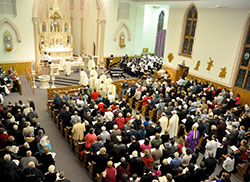Batesville Deanery recommendations to be considered by advisory boards

Catholics from across southeastern Indiana fill St. Louis Church in Batesville on Feb. 19 as Archbishop Joseph W. Tobin and several priests and deacons who minister in the Batesville Deanery process into the church at the start of a welcome Mass with Catholics from the deanery and the recently installed archbishop. (Photo by Sean Gallagher)
By Sean Gallagher
In a letter read in Batesville Deanery parishes on the weekend of March 9-10, Archbishop Joseph W. Tobin announced to Catholics in southeastern Indiana that the archdiocesan Management Council and Council of Priests will soon consider recommendations regarding the future status of faith communities in that deanery.
Archbishop Tobin will make final decisions regarding the recommendations after these groups discuss them, although he noted in his letter that parishes or groups of parishes may request an extension of time for the implementation of his decisions.
The recommendations are the result of the Connected in the Spirit process, which began in the Batesville Deanery in September 2011. Representatives from each faith community, including staff members and parishioners, participated in in the process. (Related: Indianapolis deaneries to begin Connected in the Spirit next week)
Archbishop Tobin met with representatives from parishes in southeastern Indiana on Feb. 9 at St. Mary Parish in Greensburg, and spoke with individual parishioners about the process on Feb. 19 at St. Louis Parish in Batesville after the deanery’s welcome Mass with the archbishop.
During that reception, Archbishop Tobin met Catholics who were in tears about the future of their parishes and who, at the same time, expressed their trust in him.
“It reminded me of what a great responsibility it is,” Archbishop Tobin said. “That trust that they displayed was [moving]. I went back and prayed that night with even more intensity, saying ‘God, please help us understand what is your will.’ ”
Connected in the Spirit developed through a process carried out in the Terre Haute Deanery that resulted in the closure of four faith communities in west central Indiana in 2011 and 2012.
The goals of Connected in the Spirit are:
-
To enhance the vibrancy of parish life in the Archdiocese of Indianapolis.
-
To foster an appreciation for and participation in the Sunday Eucharist and the sacraments.
-
To promote good stewardship so that parishes are financially viable now and into the future.
-
To maximize the availability of quality Catholic school education throughout the archdiocese.
-
To ensure that all parishioners have opportunities for quality lifelong Christian formation, including supporting new initiatives for youths and young adults and promoting vocations to ordained and lay ministry.
-
To strengthen service to those who are marginalized.
-
To build a greater sense of unity among the many cultures in the archdiocese.
-
To realign parishes considering the number of priests available to serve, financial resources and demographics.
-
To increase collaboration among all entities in the local, national and universal Church.
-
To advocate for peace and justice in the Church and in the world.
But Archbishop Tobin emphasized that, at its core, Connected in the Spirit has a “positive thrust” and is not driven by negative considerations.
“What we hope to be able to do is align the parishes in such a way that we can carry out the mission that’s been given to us,” he said. “It’s not so much a reductionist [approach]as a pruning where necessary to provide for future growth. I think that’s the harder piece. And I understand.”
Energizing the laity to take an active part in the proclamation of the Gospel is more at the heart of Connected in the Spirit, Archbishop Tobin said, than making parish life correspond to a declining number of priests.
“A process like this is not aimed simply at reducing the number of Masses that are celebrated because we don’t have enough priests,” he said. “Rather, we want to energize the parishes to respond even more effectively to the needs of the new evangelization.” †
